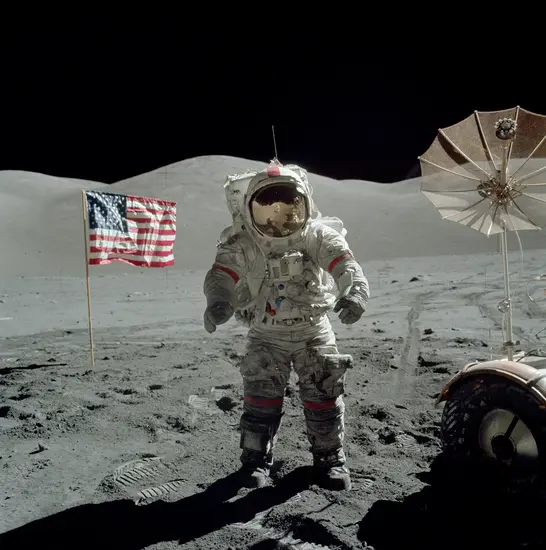
Remembering Capt. Eugene Cernan
Jan 17, 2017
By Michael Neufeld
Remembering Capt. Eugene Cernan, 1934-2017
“Gene” Cernan will always be remembered as the “last man on the Moon”—at least until the next person walks there. As commander of Apollo 17, the final expedition of that program, he spent three days on the Moon with Harrison “Jack” Schmitt. Yet that is not all he accomplished in a storied astronaut career. He was the second American and third human to walk in space, on Gemini IX-A in 1966. Cernan was also the lunar module pilot on Apollo 10, descending to less than 15,000 meters (47,000 feet) above the Moon’s surface with Thomas Stafford during the dress rehearsal for the first landing. He was one of a mere dozen astronauts to set foot there and one of only three to go to the Moon twice.
Eugene Andrew Cernan was born on March 14, 1934, in Chicago and attended school in the city and suburbs. He received an electrical engineering degree from Purdue University in Indiana in 1956, became a naval aviator and flew carrier-borne attack jets. In 1963, he completed a master’s in aeronautical engineering at the Naval Postgraduate School, the same year he was selected to be one of the third group of NASA astronauts.
The unfortunate death of the Gemini IX prime crew in an airplane crash vaulted him into the right seat of a trouble-plagued mission, renamed Gemini IX-A after the first docking target failed to reach orbit. Launched on June 3, 1966, Cernan flew with Thomas Stafford as commander. He made his spacewalk two days later, with the goal of strapping on a jet pack and flying around the capsule. But he found the effort of putting the pack on was utterly exhausting. He reportedly lost 6 kilograms (13 pounds) of water, his visor fogged up and he barely made it back inside the spacecraft. His nearly fatal spacewalk spurred NASA to overhaul its spacesuits and training methods significantly. Afterward, Cernan made important contributions to extravehicular activity (EVA) preparation, establishing underwater simulation as the essential training method for spacewalks.
Three years later, Cernan flew again with Stafford as commander (and John Young as command module pilot) on only the second human mission into lunar orbit. Apollo 10 launched on May 18, 1969, and demonstrated that every system was ready for landing on the Moon during the next mission. His excellent performance contributed to him being given command of the last lunar landing, which took off on December 7, 1972. He and Schmitt (the command module pilot was Ronald Evans), broke all previous records for time spent outside a spacecraft (22 hours), distance traveled (35 kilometers (21.7 miles) and samples gathered (110.4 kilograms (243 pounds) during lunar extravehicular activity. As he stepped off the Moon on December 14, 1972, he said:
I believe history will record: that America's challenge of today has forged man's destiny of tomorrow. And, as we leave the Moon at Taurus–Littrow, we leave as we came and, God willing, as we shall return, with peace and hope for all mankind. Godspeed the crew of Apollo 17.
Cernan retired from the astronaut corps and the Navy in July 1976, after helping manage the Apollo-Soyuz docking mission with the Soviet Union a year earlier. He then served in corporate management positions and as a television commentator for space shuttle missions. His readable memoir, The Last Man on the Moon (1999), led to an award-winning documentary of the same name, released in 2016. Perhaps the most articulate of the Moon-walking astronauts, he felt that it was his mission to make his audiences feel as if they had been there too, including those who witnessed his memorable talk at this Museum in 2003. He will be missed.
Michael J. Neufeld is a historian in the Space History Department of the National Air and Space Museum, where he is curator, among other things, of Gemini spacecraft. He is leading the content team for Destination Moon, a new exhibition about lunar exploration that is to open in 2020.
Related Topics
You may also like
Related Objects

We rely on the generous support of donors, sponsors, members, and other benefactors to share the history and impact of aviation and spaceflight, educate the public, and inspire future generations. With your help, we can continue to preserve and safeguard the world’s most comprehensive collection of artifacts representing the great achievements of flight and space exploration.
Support the Museum
We rely on the generous support of donors, sponsors, members, and other benefactors to share the history and impact of aviation and spaceflight, educate the public, and inspire future generations. With your help, we can continue to preserve and safeguard the world’s most comprehensive collection of artifacts representing the great achievements of flight and space exploration.







